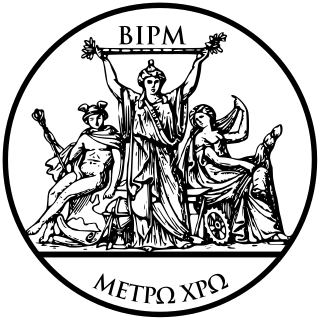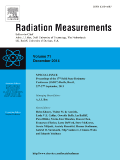Notes and references
- ↑ Based on definition from NCRP Composite Glossary. (reports published during the period 1991 to 2006)
| Biodosimetry |
|---|
Biodosimetry is a measurement of biological response as a surrogate for radiation dose. The International Commission on Radiation Units and Measurements and International Atomic Energy Agency have issued guidance on performing biodosimetry and interpreting data. [1]

The International Bureau of Weights and Measures is an intergovernmental organisation, through which its 59 member-states act together on measurement standards in four areas: chemistry, ionising radiation, physical metrology, and coordinated universal time. It is based in Saint-Cloud, Paris, France. The organisation has been referred to as IBWM in older literature.
Background radiation is a measure of the level of ionizing radiation present in the environment at a particular location which is not due to deliberate introduction of radiation sources.
Nuclear engineering is the branch of engineering concerned with the application of breaking down atomic nuclei (fission) or of combining atomic nuclei (fusion), or with the application of other sub-atomic processes based on the principles of nuclear physics. In the sub-field of nuclear fission, it particularly includes the design, interaction, and maintenance of systems and components like reactors, power plants, or weaponry. The field also includes the study of medical and other applications of radiation, particularly Ionizing radiation, nuclear safety, heat/thermodynamics transport, nuclear fuel, or other related technology and the problems of nuclear proliferation. This field also includes chemical engineering and electrical engineering.

The sievert is a derived unit of ionizing radiation dose in the International System of Units (SI) and is a measure of the health effect of low levels of ionizing radiation on the human body. The sievert is important in dosimetry and radiation protection, and is named after Rolf Maximilian Sievert, a Swedish medical physicist renowned for work on radiation dose measurement and research into the biological effects of radiation.

Zond 7, a formal member of the Soviet Zond program and unmanned version of Soyuz 7K-L1 manned Moon-flyby spacecraft, the first truly successful test of L1, was launched towards the Moon on a Proton-K D rocket on August 7, 1969, on a mission of further studies of the Moon and circumlunar space, to obtain color photography of Earth and the Moon from varying distances, and to flight test the spacecraft systems. Earth photos were obtained on August 9, 1969. On August 11, 1969, the spacecraft flew past the Moon at a distance of 1984.6 km and conducted two picture taking sessions. On its way back from the moon the spacecraft tested its radio systems by transmitting recorded voices. Zond 7 reentered Earth's atmosphere on August 14, 1969, and achieved a soft landing in a preset region south of Kustanai, Kazakhstan. On its trip the craft carried 4 turtles. A human-like tissue-equivalent phantom for radiation measurements has been placed aboard. The phantom was equipped with 20 channels for radiation detectors distributed along the whole body for measurement of doses in critical organs. The doses accumulated during the flight through the radiation belts and around the Moon were between 0.2 and 0.7 rad in different points at the depth of 3 g/cm2 from the body surface.
Medical physics deals with the application of the concepts and methods of physics to the prevention, diagnosis and treatment of human diseases with a specific goal of improving human health and well-being. Since 2008, medical physics has been included as a health profession according to International Standard Classification of Occupation of the International Labour Organization.
The gray is a derived unit of ionizing radiation dose in the International System of Units (SI). It is defined as the absorption of one joule of radiation energy per kilogram of matter.
Radiation dosimetry in the fields of health physics and radiation protection is the measurement, calculation and assessment of the ionizing radiation dose absorbed by an object, usually the human body. This applies both internally, due to ingested or inhaled radioactive substances, or externally due to irradiation by sources of radiation.
Absorbed dose is a dose quantity which is the measure of the energy deposited in matter by ionizing radiation per unit mass. Absorbed dose is used in the calculation of dose uptake in living tissue in both radiation protection, and radiology. It is also used to directly compare the effect of radiation on inanimate matter such as in radiation hardening.

Radioactive contamination, also called radiological contamination, is the deposition of, or presence of radioactive substances on surfaces or within solids, liquids, or gases, where their presence is unintended or undesirable.
The rad is a unit of absorbed radiation dose, defined as 1 rad = 0.01 Gy = 0.01 J/kg. It was originally defined in CGS units in 1953 as the dose causing 100 ergs of energy to be absorbed by one gram of matter. The material absorbing the radiation can be human tissue or silicon microchips or any other medium.
The International Commission on Radiological Protection (ICRP) is an independent, international, non-governmental organization, with the mission to protect people, animals, and the environment from the harmful effects of ionising radiation. Its recommendations form the basis of radiological protection policy, regulations, guidelines and practice worldwide.
The International Commission on Radiation Units and Measurements (ICRU) is a standardization body set up in 1925 by the International Congress of Radiology, originally as the X-Ray Unit Committee until 1950. Its objective "is to develop concepts, definitions and recommendations for the use of quantities and their units for ionizing radiation and its interaction with matter, in particular with respect to the biological effects induced by radiation".

A pyrheliometer is an instrument for measurement of direct beam solar irradiance. Sunlight enters the instrument through a window and is directed onto a thermopile which converts heat to an electrical signal that can be recorded. The signal voltage is converted via a formula to measure watts per square metre.

Radiation monitoring involves the measurement of radiation dose or radionuclide contamination for reasons related to the assessment or control of exposure to radiation or radioactive substances, and the interpretation of the results.
David A. Schauer, ScD, CHP, is Executive Director Emeritus of the National Council on Radiation Protection and Measurements (NCRP). During his tenure a number of updated and new publications were issued by the Council.

The roentgen or röntgen is a legacy unit of measurement for the exposure of X-rays and gamma rays, and is defined as the electric charge freed by such radiation in a specified volume of air divided by the mass of that air . In 1928, it was adopted as the first international measurement quantity for ionising radiation to be defined for radiation protection, as it was then the most easily replicated method of measuring air ionization by using ion chambers. It is named after the German physicist Wilhelm Röntgen, who discovered X-rays.
Eileen Gail de Planque was an American nuclear physicist. An expert on environmental radiation measurements, she was the first woman and first health physicist to become a Commissioner at the US government's Nuclear Regulatory Commission (NRC). Her technical areas of expertise included environmental radiation, nuclear facilities monitoring, personnel dosimetry, radiation shielding, radiation transport, and solid state dosimetry.

Radiation Measurements is a monthly peer-reviewed scientific journal covering research on nuclear science and radiation physics. It was established in 1994 and is published by Elsevier.

A radioactive source is a known quantity of a radionuclide which emits ionizing radiation; typically one or more of the radiation types gamma rays, alpha particles, beta particles, and neutron radiation.